Recession odds have climbed considerably since Jerome Powell’s testimony before Congress and the latest FOMC meeting. However, the recent failures of Silicon Valley Bank (SVB) and Credit Suisse (CS), as higher rates impact regional bank liquidity, also added to the risks.
This isn’t the first time we have warned the aggressive rate hiking campaign would either cause a recession or “break something.”
- A “Soft Landing” Scenario – Possibility Or Fed Myth
- “No Landing” Scenario At Odds With Fed’s Goals
- The Lag Effect Of The Fiscal Pig & The Economic Python
- The “Policy Pivot” May Not Be Bullish
- This Time Is Different – The Fed’s Next “Minsky Moment”
You get the idea. We have been warning of the risk for quite some time. However, the financial markets continue to ignore the warnings.
The Fed remains abundantly clear that it still sees inflation as a “persistent and pernicious” economic threat that must be defeated. As we noted previously, the problem is that in an economy dependent on debt for economic growth, higher rates eventually lead to an “event” as borrowing costs and payments increase.

As debt service increases, it diverts money from consumption which fuels economic growth. Such is why consumer delinquencies are now rising due to the massive amount of consumer credit at substantially higher rates. Notice that when the Fed begins cutting rates, delinquencies decline sharply. This is because the Fed has “broken something” economically, and debt is discharged through foreclosures, bankruptcies, and loan modifications.
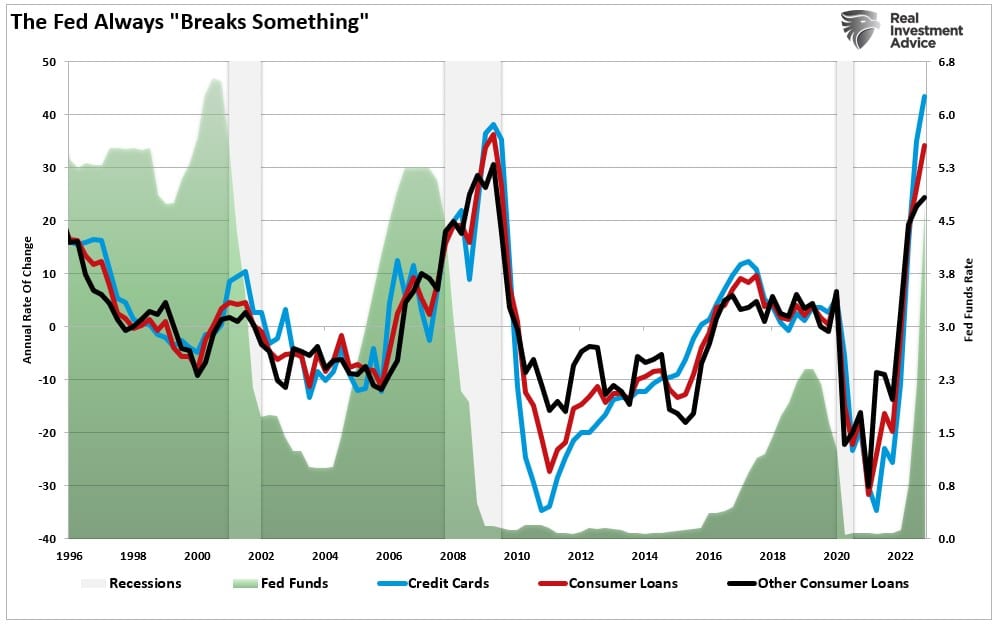
Of course, given that consumption is roughly 70% of the economic growth calculation, the consumer is the lynchpin.
Ringing Alarm Bells
While the percentage of delinquent consumer loans is not problematic, the sharply rising trend is. Further, Heather Long of the Washington Post notes:
“Many households are also behind on their utility bills: 20.5 million homes had overdue balances in January, according to the National Energy Assistance Directors Association.”
Per the article, the bottom 60% of earners contribute about 40% of GDP growth. People delinquent on loans are likely getting financially squeezed due to falling real wages and will be forced to reduce their consumption. If the unemployment rate rises, the problem will worsen. The article ends as follows:
“The flares are going off. If the economy does fall into a recession, it will only get more perilous for those at the bottom.“
The deep yield curve inversions are a sign that recession odds are increasing.
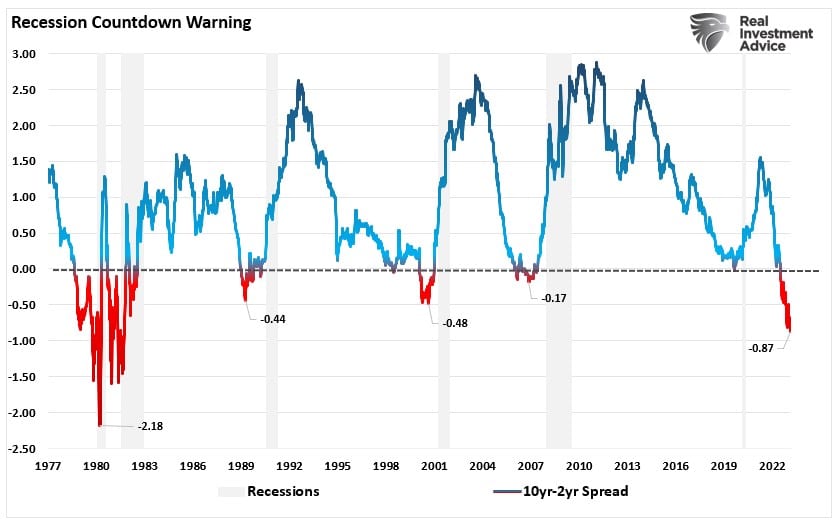
The current inversion of the 10-year interest rate and the 2-year interest rate is now at the deepest level since Paul Volcker was engineering hikes that broke the back of double-digit inflation at the cost of two back-to-back recessions.
However, there is a significant difference between now and the 1970s, which is the dependency on debt. As shown, household net worth has far outstripped gains in disposable income. Such was a function of a continuous decline in borrowing costs and massive increases in leverage.
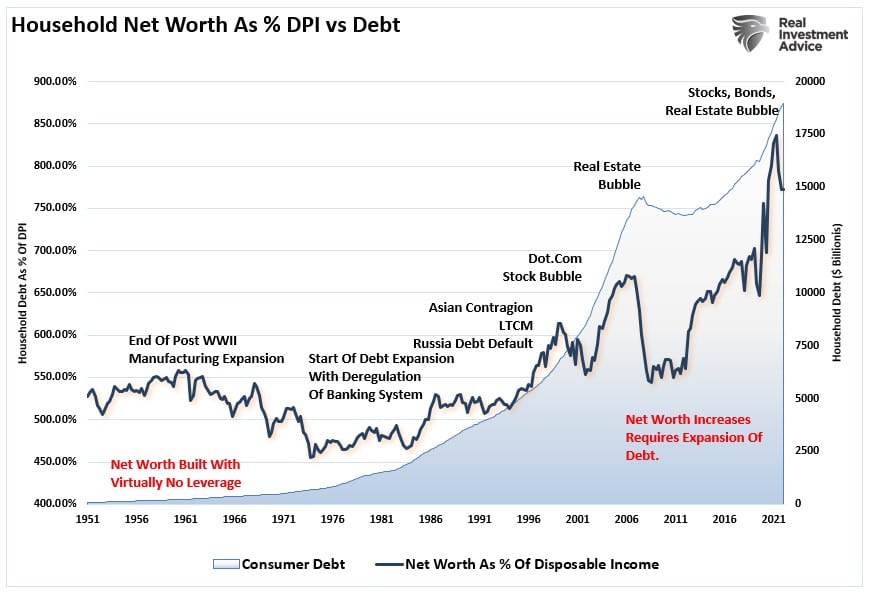
Not surprisingly, as repeated throughout history, sharp spikes in net worth as a percentage of disposable incomes are a function of asset bubbles or other economic or financial distortions. As recession odds increase, the result is the reversion of those distortions.
While often villanized by the media and by politicians, recessions are a “good thing,” economically speaking. If allowed to complete its full cycle, it removes the excesses built up in the system from the preceding expansion. This “reset” enables the economy to grow organically in the future.
The problem today is that the Federal Reserve has repeatedly cut short the “recessionary cleansing” needed to reset the economy to a healthier status.
The Fed may be tapped between two potentially harmful outcomes.
Mr. Powell Meets Rock
Mr. Powell, and the Federal Reserve, are caught between the proverbial “rock and a hard place.” In this case, the “rock” is the Fed continuing to fight inflation by hiking interest rates and slowing economic growth. However, the “hard place” is that each rate hike further increases the strain on consumers and, as seen with Silicon Valley Bank, the financial system.
If Silicon Valley Bank was the warning shot of more bank failures, the Federal Reserve will have to pivot on monetary policy to bail out more banks. However, such will not be bullish for investors as the bailouts will occur during a deepening recession and falling earnings. This is not the environment you want to own overvalued instruments based on falling earning estimates.
Furthermore, if the Fed abandons its inflation fight and begins to bail out the economy, it will cause a resurgence of inflation. Such will either immediately Fed back into a rate hiking campaign, causing another crisis, or they will have to let inflation ravage the economy.
Critically, the Federal Reserve had never faced needing to provide liquidity to the financial system when inflation was high. Since 2008, inflation has been “well contained,” allowing the Fed to lower rates and provide “quantitative easing” to stabilize markets and financial systems. That is not the case today.
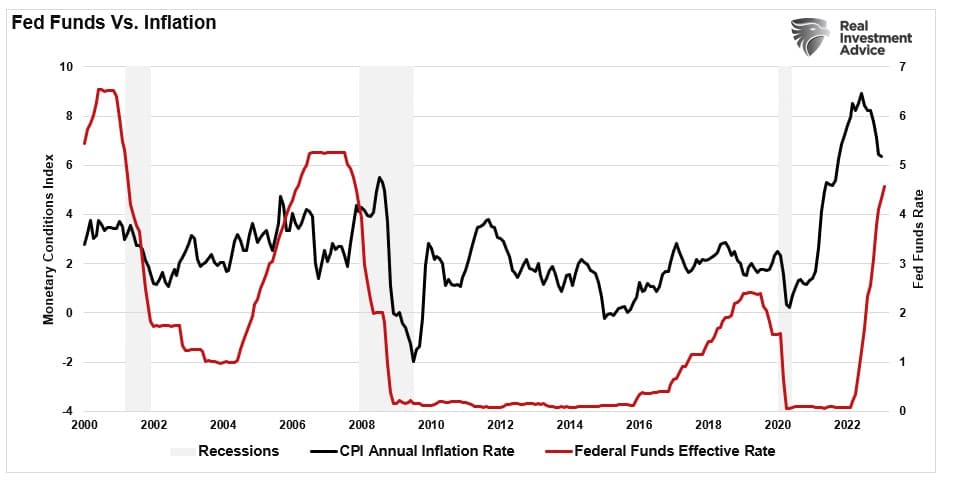
There seem to be no good choices for the Fed as the inflation-fighting credibility Powell has earned with the markets comes with a cost.
“The issue is the tighter you keep borrowing conditions for the private sector, the higher you keep mortgage rates, the higher you keep corporate borrowing rates, the higher the chances you’re going to freeze these credit markets and basically sleepwalk into an accident or, in general, accelerate a recession later on.” – Alfonso Peccatiello.
The M2 Connection
Alfonso is correct, and the contraction in nominal M2 is ringing alarm bells. Such was a point Thorsten Polleit via The Mises Institute recently noted.
“What is happening is that the Fed is pulling central bank money out of the system. It does this in two ways. The first is not reinvesting the payments it receives into its bond portfolio. The second is by resorting to reverse repo operations, in which it offers “eligible counterparties” (those few privileged to do business with the Fed) the ability to park their cash with the Fed overnight and pay them an interest rate close to the federal funds rate.”
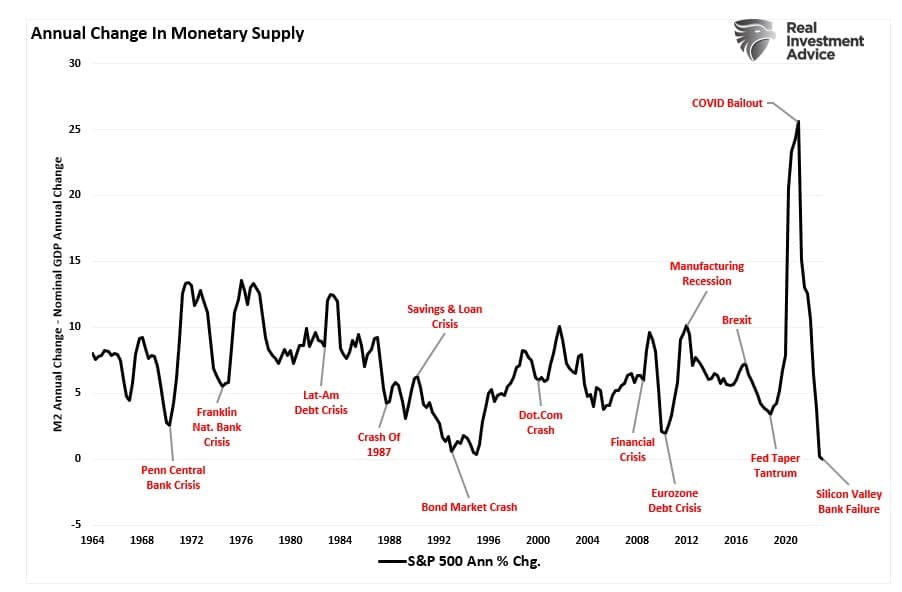
As shown, contractions in nominal M2 have coincided with financial and market-related events in the past. Such is because the Fed is draining liquidity out of the financial system, which is ultimately deflationary. The reason that recession odds are increasing is that the drain is deflationary and economic growth is slowing. As Thorsten concludes:
“The Fed has announced that it intends not only to raise interest rates further but also to reduce its balance sheet and sponge up central bank money.”
This, in turn, implies a real risk that the Fed will overtighten, causing a recession.
Silicon Valley Bank is likely the casualty of the coming economic battle.
The post Recession Odds Jump As The Fed Crushes Consumers appeared first on RIA.

